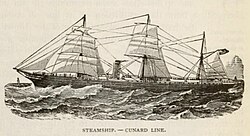Russia (ship)
|
||||||||||||||||||||||
|
||||||||||||||||||||||
|
||||||||||||||||||||||
|
||||||||||||||||||||||
|
||||||||||||||||||||||
The Russia was a passenger ship put into service in 1867 by the British shipping company Cunard Line , which was used in liner service on the North Atlantic from Liverpool via Queenstown to New York . She was the third steamer from Cunard with sails and steam engines that was propelled by a ship's propeller and was also considered one of the fastest and most elegant passenger steamers of its time. In 1880 the Russia was sold to the Red Star Line and renamed Waesland . She sank on March 5, 1902 after a ship collision off the island of Anglesey .
history
The 2,960 GRT steamship Russia was built in Clydebank (Scotland) at the shipyard of J. & G. Thomson, the predecessor of John Brown & Company , and was launched on March 20, 1867. The ship, which was 109.11 meters long and 12.77 meters wide and made of iron, had the clipper stern that was mandatory for Cunard at the time , a chimney, three masts and a single propeller. The Russia was Cunard's third screw steamer (previously the ships were still powered by paddle wheels). It was equipped with composite steam engines from the shipyard, which developed 3100 PSi , allowed a speed of 14 knots (25.9 km / h) and consumed 90 tons of coal a day.
On June 15, 1867, the Russia cast off in Liverpool, where she was also registered, under the command of Captain Theodore Cook, the commodore of the Cunard fleet, on her maiden voyage via Queenstown to New York. She established herself as a fast and comfortable ship, whose elegant outer lines and comfortable interior were well received by the public. The ship was built for wealthy travelers and could take 235 first class passengers on board, although there would have been room for significantly more passengers. The passenger accommodations were later expanded to accommodate a total of 430 passengers.
There has never been an accident during the entire service at Cunard. During these years many prominent persons were on board as passengers, including Emperor Peter II and Empress Teresa of Brazil, Alfred Duke of Saxe-Coburg and Gotha , the US entrepreneur George Peabody and Hugh Childers , First Lord of the Admiralty from 1868 to 1871 .
In 1880 the Russia was sold to the Belgian-American shipping company Red Star Line based in Antwerp and renamed Waesland . The hull was lengthened from 109.11 meters to 132.6 meters, so that the ship's measurements increased from 2960 GRT to 4752 GRT. A fourth mast was also added and the old steam engines were replaced by new ones.
The ship ran out on December 6, 1880 for the first voyage for the new owners on the usual Red Star route Antwerp - New York. In 1889 J. & G. Thomson equipped the Waesland with new triple expansion steam engines. On August 17, 1895, she ran from Antwerp to New York for the last time. From September 11, 1895, she was chartered by the American Line , based in Philadelphia , and used for regular services from Philadelphia to Liverpool. The passenger accommodation was redesigned for 120 second and 1500 third class passengers. On March 5, 1902, the Waesland sank off Anglesey on the north coast of Wales after colliding in the fog with the British steamship Harmonides . Two people were killed.
Web links
- A comprehensive description of the ship can be found in The Ships List
- Detailed information on the construction and history of the ship
- The Russia in the Clydebuilt Ships Database (with picture)
- Short tabular representation in Norway Heritage (with picture)
- Report on the 99th Tour of Russia in the New York Times of May 29, 1878
- Development of the Cunard ships
